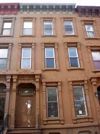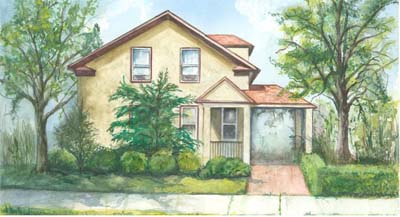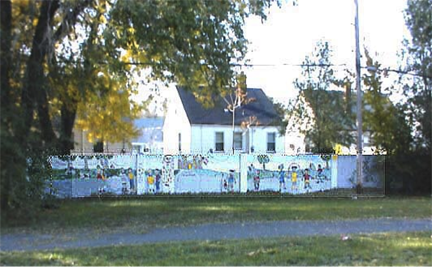Migrations II

Chad and Jeremy are out of here this morning. The U-Haul truck is parked in the back, over the strong objection of management.
Jeremy laughed about it at Union Jack last night at the farewell at Kate’s back bar. “So, I like went in to the office to tell them that I was parking the truck in the back, and they said I couldn’t.” He shrugged his narrow shoulders in his usual dismissive way. “So, I said, like what are you going to do? Make us leave?”
He had spent the last day moving crap himself. Chad was wrapping up his affairs in his office at the Dollar Store HQ where he serves as a security advisor, preventing newly frugal Americans from ripping off low-cost items.
They are headed for the beach in Delaware. When he arrived, fashionably late, he said this migration was going to work out really well, and he wanted the Big Pink crowd to feel comfortable coming up and sleeping on the couch.
“A block from the beach,” he said with authority. “And a block from the bar. It is going to be perfect.”
I had to agree with the migration, though I will be sad to lose the energy of youth at our quirky old building. So did Marty 1, and Mandy, and Slick and Kathy and Chas and Mary Margaret and Joe who made up the core group of Big Pinkers that lined the bar to see them off.
In my decade in the building, I have to say that Chad and Jeremy were one of the “It Couples” that have graced its stately halls. They own 2008-9, the year that everything, the pool, the economy, real estate values and life in general came off the rails.
That summer seemed to mark a tipping point of sorts. Remember? I vividly recall doing the numbers that summer and realizing we were no-shit going to elect an African-American man to the presidency; gay couples were nothing to comment about, everything was in a sort of free fall that was scary and filled with an odd combination of dread and hope.
Chad and Jeremy pushed all the limits while they were here, though they have been a little more constrained since that first summer. Then, they hung at the pool, blatantly ignoring several of the ore prominent Regulations with impunity, which ultimately resulted in the legendary Revolt of the Grandmas and an emergency meeting of the Condo Board.
I made my exit after a decent interval, early by their standards, but I live on a different rhythm than they do, and the evening is for the young. I strode along the concrete toward the garage under the Westin Hotel where the Hubrismobile was waiting, thinking about moving and migrations.
A decade, I thought, waiting for the long light to change at the intersection of Wilson and Glebe road. A full ten years at Big Pink. Maybe it is getting on toward time to leave, I thought. If the currency collapses, as I think it might, the fixed year mortgage is going to be a good deal, an anchor to the past when a dollar meant something. On the other hand, the Condo fees are going to soar with inflation, effectively wiping out the fixed income residents just to keep the building heated and the lights on.
Maybe time to get out from under the obligation and rent someplace, like Chad and Jeremy are going to do in Delaware.
That would mean coming unstuck in place, moving again, and looking at the real estate prices in Detroit I was tantalized by the possibilities. A house for pocket change, I marveled, looking at the prices of the first houses my folks lived in when they migrated from New York City to the booming industrial Mecca of Detroit.
Of course, buying property in the sprawling wasteland of what used to be the Motor City would leave you in Detroit, a 113-square mile former urban desert dotted only with islands of civilization.
What a change, I thought. Almost unimaginable, though they are asking us to imagine a lot of things these days. I got a link to an amazing set of footage taken of the first American jet aircraft. Here it is, if you have not seen something like this, a moment captured in sepia from 1942. The wonder of the Bell P-59 Airacomet is palpable, just like the skinny pilots of another, earlier America.
http://www.aircraftowner.com/videos/view/americas-first-jet-flight-october-1942_1617.html
I marveled at the whole thing. Seventy years from the first jet to landing on the moon and then tossing the Space Shuttle on the ash-heap of history. Easy come, easy go, just like Detroit.
It was so different in the world that Word War II created, and which we finally have just about used up.
I still have a Hitler Youth flag that was liberated by one of the young men from Ohio in the ETO. It has the original tags on it. Nino- I think that was the name- gave it to Magpie, who was living at Spellman Hall on Hudson Street in Greenwich Village while she worked in the exotic art deco Chrysler Building for the Texas Company as an executive assistant.
Nino was headed back to the Valley, flush with enthusiasm and hoping for something more from Mom than he did not get. I think he regretted giving it up in exchange for a peck on the cheek. Most of the young men were headed back to the Valley.
Not her.
On a blind date arranged by a guy named Ray Rappaport in 1946 she met a striking young Naval Aviator who had the smoldering dark looks of movie star Gregory Peck. He was named Bill, and things clicked, despite an early misapprehension about the large gold Masonic ring he sported which made her think he was a married guy on the make. They got that sorted out, and smoked Chesterfields and wore beer jackets and enjoyed the bright lights of Manhattan.

In 1947, they married and moved into a little place at 123 St. James Place in Brooklyn where Bill was studying at Pratt Institute’s Clinton Hill campus. It was a quirky old apartment building. The electricity would go out when all the young couples would try to cook all at once in the evening, but that was just the way things were after the war.
They moved to 294 Cumberland Street where the power was a little more reliable, also in Brooklyn, until 1949. Dad almost completed his degree, but the lure of opportunity and big money was too much for a couple making not much more than a secretary’s pay and the modest but welcome benefits of the GI bill.
The opportunity was represented by the magnet of Detroit, the Arsenal of Democracy. The rise of the city sucked African Americans from across the south and closed the books on the Great Depression. In addition to the agricultural workers and women who sustained the war industry while the Boys were overseas, conversion of the munitions and aircraft plants back to civilian consumer goods attracted young vets.

Massillon, Ohio, was the little town where Grandma lived after grandpa Mike died. She married Evan, and moved into his house there on North Ave, escaping sad little Bellaire on the river. The little house with the chocolate-colored tile driveway still slumbers there near the Women’s Club, on I-77 south of Akron.
The Ohio and Pennsylvania Turnpikes were the route of migration that Magpie and Raven followed to their dreams in Detroit, through the hills of the Keystone State and onto the long straight-away across the flatlands.
The auto companies in Detroit were hiring, and Raven got a line on a job with Ford’s, which is what we still called FoMoCo as if Henry were still at the tiller. The job was one of the sexy ones, in the styling shop. Dad had not completely finished his course work at Pratt Institute on the GI Bill, but it was time to move on. The Ohio Turnpike was under construction that year, following the route of the old railroad, and I remember for years afterward riding in the back of the Ramblers as the four-lane snake finally reached all the way to hook up with the Pennsylvania Turnpike.
They took the Big Chance, when the Ford Motor Company really got rolling with the first sleek post-war designs of 1948 and started to hire bright young men to design the future. The women who had built the bombers at Willow Run and stacked ammunition were encouraged to go home, and make way for the Boys who served.
They pulled up stakes and headed for the Midwest in the pre-war Ford Model A.
They could not afford to move into the city at first, and secured lodgings in suburban Ferndale, just a mile or so from the city limits.
They found the place at 1514 Pinecrest before moving into town to be closer to Dad’s job at Ford’s. They were at 14987 Sussex St when I was born in 1951, and later, the first place I remember at 14230 Kentucky Street.
They were not far from the Wall at Eight Mile. In 1940, this section of Detroit was ripe for development. Water and sewer lines had just been extended, but there was a problem. Some Negro citizens of Detroit had moved into the area when it was fallow and had built modest homes.

With the coming of World War II, a developer sought to construct houses for middle-class whites, just across the city limit at Eight Mile. He began his development but was dismayed to discover that his prime location had a problem: the FHA would not back loans there since the Home Owner’s Loan Corporation (predecessor of Fanny Mae) had coded the area in red.
To overcome this challenge, he built a concrete wall, 6 feet in height and one-half mile long from the western boundary of what is now the Alfonso Wells Memorial Playground north from Eight Mile Road to the intersection at Wyoming Boulevard.
I doubt that Mom and Dad knew anything about the Wall, since they were renters and took what was on the market. The Wall served its purpose. Loans were made, and the houses went up.
Then there was a choice about where to live, at least for white folks, but none wanted to live in a red-lined neighborhood.
The developers had an angle- as we have come to find out, they always do. The Realtors would buy a home in a green area, and move in an African American family. It drove the white families out in a panic, seeing the prospects of their green homes turning crimson on a banker’s map, and the real estate peopled pocketed the cash they made in changing the composition of the city.
When the John C. Lodge Expressway was slashed along the course of Woodward Avenue, it became easy to get way from the city. Later, when the north-south artery of I-75 was bulldozed through the old Paradise Valley/Black Bottom neighborhood, the main African-American neighborhood was paved over. With the demand for housing being what it was, the African American families were willing to pay a premium to get it.
With the coming of the new mega-roads, the auto companies began to disperse their manufacturing operations away from the city proper, and the seniority system ensured that the last-hired were first-fired. The industry that had acted as a magnet to employ African-Americans from the South began to shed young men. It was the beginning of a permanent underclass in the city, a large pool of unemployed and unemployable men and women.
Then came the riots of 1967 and 1968 and overnight, the city became overwhelmingly poor and black.
That was the Detroit I came back to in the summer of 1973. It was quite an education. But we will have to get to that tomorrow.
Copyright 2008 Vic Socotra
www.vicsocotra.com
